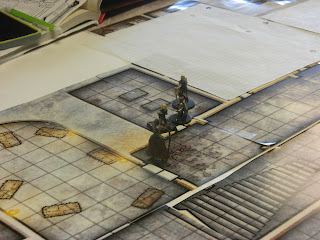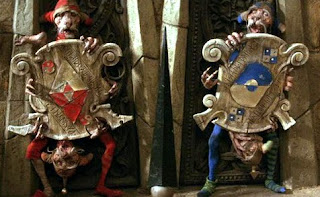One of the cornerstones of any good role-playing game should be the creativity of the players to deal with the challenges laid out by the Dungeon Master, as well as the DM's ability to adapt and respond to the choices of the players. Part of the fun is hearing the elaborate plans that are concocted and then implemented, thinking of fun wrenches to throw into the plan to make it dramatic, and seeing how it all would resolve. When the players put effort into thinking up creative ways to use their character's abilities and how to shoehorn in that bag of sand that has been sitting in their inventory since level 1, it results in the types of stories that get reminisced about after the game is over. This give-and-take is essential to tabletop storytelling.
With D&D 5e, I have found myself frustrated at many tables because of the lack of description in player actions. I began to find myself bored when players declare that they are going to perform a "perception check" or are about to "roll to intimidate this guy" with no real direction for what the action would look like. And though I might try to elicit more detail, the roll would occur and a roll of "25" would be reported, indicating extreme success, and I would feel pressured to allow it and move on to favorable results. I was sharing a lamentation many DM's have felt before, the game was beginning to feel like 'roll'-playing instead of role-playing.
I roll 3d4+3 at the darkness!
This problem is part of the reason why I am coming to appreciate more and more the ambiguity of the older D&D Basic system and now DCC when it comes to specific character abilities. The lack of a specific number or statistic assigned to a distinct skill encourages the description of the action being performed. Not only do the actions get a verbal illustration but it provides an opportunity for players to put personality into how they perform a task. A careful and patient rogue might investigate a fountain by gingerly running a net through the water, while an impatient warrior might jump in and start splashing around looking for castaway coins.
The Yawning Portal adventure book came out in April and offered to bring to 5e a number of older dungeon crawls from past editions. Starting at level 1 with Sunless Citadel all the way up to the infamous Tomb of Horrors, I was excited to get my groups delving into some complex dungeons, but felt concerned that they might become boring and stale with the play styles that had become the norm.
"Cruel, but most entertaining for the DM." -Gary Gygax
I like 5e because it allows players to feel like super heroes in a fantasy world while still providing challenge in combat and being streamlined enough that I can feel confident as a DM using it to tell my story. But it still holds onto the skill systems of the past that can discourage creativity. While its much more simplified than 3.5/Pathfinder, it is still an element of the game that players and DM's alike often rely on as a crutch. Because the system doesn't inherently promote the descriptive play-by-play I yearned for from my players, I knew that I was going to have to work to try to facilitate it. Here are some of the things I have been trying to keep in mind as I have run my Yawning Portal games:
Skill Checks Only Allowed When Asked for by DM
Skill checks really are only necessary when there is a chance at success/failure. Many players I see will proclaim they are performing a particular check. The roll will oftentimes happen before I can respond, and then when the player excitedly says "I got a 27!" I feel pigeonholed into indicating that it has an effect on the situation. This ruins the game for a number of reasons. First off, it creates this idea that anything is possible with a good roll of the dice, which shouldn't be the case. If you are trying to convince your arch-nemesis to take you to lunch and pick up the bill, a really high persuasion check isn't going to do that. In that scenario success isn't possible, and thus a skill check would never be prompted.
The second problem is that it is lazy and provides no flavor to the scenario. If it is a social interaction, it doesn't mean that the player has to talk in a funny voice and give the table a huge performance (although if they want to, that's great!). But simply adding some description to how their character talks, slipping in some innuendo, what are they referencing, etc., etc. In a situation where a character is trying to inspect a room for traps, its more interesting to hear a player say "I walk around the perimeter of the room cautiously, inspecting the walls as I do so and tapping a staff in front of me to locate any false floors" than "I am going to perform an investigation check."
Avoid Describing Results in Terms of Success/Failure
One of the techniques I have started employing is to not respond to skill checks by openly stating if they succeed or fail. Instead, I describe what the character experiences and perceives. In situations where a trap is involved, this helps to add a certain degree of suspense to the game. For example, I recently had a player come upon a trapped chest that had a device built into it that would shoot a poison needle when opened. I described how the player noticed that an alteration had been made to the lock, and it seemed like there was a silvery glint inside the keyhole. They used their thieves' tools to attempt to disarm the trap. Instead of telling the player that their check succeeded, I described that they were able to pry the needle out of the trap. This outcome can spur questions: could there be more needles inside? Is it worth opening? Alternatively, if the check was a failure, you could give the same description and the outcome could be yes, indeed, there was more than one needle. This makes it such that the suspense of the situation does not completely dissolve as soon as the die is rolled.

Make More Rolls Behind the Screen
For some skill checks, I have found that the meta-knowledge of the players can be diminished a bit if the DM rolls particular checks behind the screen. For 5e, the ones that I have started to make a habit of this are
perception,
investigation,
persuasion and
insight checks. The reason is, if a player sees that they roll particularly bad they will hesitate to move forward with their task or tag another player in to try instead. If they see that the rolled a 5 on an insight check while they were questioning a prisoner, they are going to treat that as an uncertainty and may even likely assume that the prisoner is trying to deceive them simply because the check was called for. Rolling behind the screen makes the player rely on the description of what is happening rather than being able to derive some knowledge based on the number they see being rolled.
Fishing for Success
Some players will ask questions like "if I tie a rock to this piece of rope and cast light on it, and then I throw this rope across this chasm, do I feel like there might be some invisible creature on the otherside that will grab the rope and pull me over?" Okay, maybe no one has asked such an egregious question but its come close. Players may fish for the outcome of a possible plan they have without putting any risk in to testing the plan. This is something the DM should try to stop as soon as they notice it happening. The right response is "tell me what your character is doing." Running through all the possible scenarios with the DM and rating them for success/failure is a pretty boring way to spend a session; better to have the players experiment and learn for themselves.
Don't Be Hasty
I have tried to make skill check scenarios more interesting and exciting by describing what happens incrementally. On a failed perception check, instead of saying that the character leading the way down a tight corridor just stepped on a pressure plate and flashes of lightning strike down the corridor dealing 45 points of damage, its more suspenseful to describe the act of stepping on the pressure plate and gauging the reactions. A gulp...sweat pouring down everyone's face as you describe that everyone's arm hair is standing on end as a pulse of blue light seems to be hurdling down the corridor. Maybe the players even describe the futility of an attempted escape to then get the report of how much damage they took.
Knowledge Checks...Who Needs Them?
It is not uncommon for me to sit at a full table and find that not one player has chosen a knowledge based skill such as
nature,
religion,
arcana or
history. With these four skills, I have made it a habit that only those characters that have chosen it as a proficiency may roll to see if they have studied or come upon the knowledge in their pasts. These skills do tend to get used less frequently, and I feel this is appropriate unless a player can make a case as to how their backstory related to the circumstances of the knowledge check.
Reward them by allowing fun things to happen
Allow the players to do things sometimes that aren't mechanically allowed with rules as written, but just seem fun. While running a particular adventure recently, the characters were all beat up pretty bad. The gnome wizard was trying to lead the way as the goliath warrior carried his warlock friend. They were in a room with a strange tree in a pool that seemed to awaken as they entered. Being in no condition to fight this monstrosity, the group crossed the room to try to avoid it and escape out the passage on the other side. Unfortunately, I called for a skill check as they crossed which resulted in a failure, and the warrior dropped his companion on the ledge he was crossing en route to the other side. The tree reached down to grab the prone and unconscious warlock as the two surviving members devised a plan to recover their friend. The wizard cast levitate on the warrior who, using a rope and grappling hook, snagged the belt of his friend while hovering on the ceiling above his body. A game of tug of war occurred with the tree, a struggle, but eventually the warrior won and recovered the body of their ally who they brought to a nearby room to revive.
Final Thoughts
I am very happy to report that after running the first three chapters of Yawning Portal and doing some of the things I have described above, I have found that the players do engage more with the game. From Tabaxi characters going to great lengths to avoid a few inches of water on the floor to a character using their
speak with animals spell to negotiate a love story between two rats encountered in a dungeon. I'm finding players poking at things with swords and agonizing over turning dials clockwise or counterclockwise (and lengthy debates as to why one is inherently better than the other). When this kind of stuff happens you get a better story, greater group cohesion, and a more memorable experience that will get people excited for the next time everyone gets together for D&D night.


























